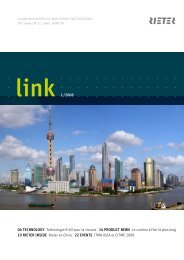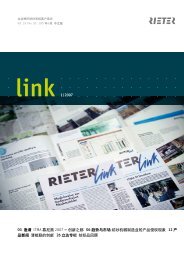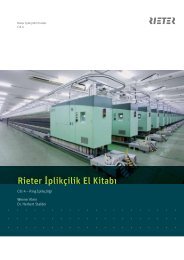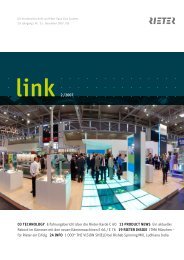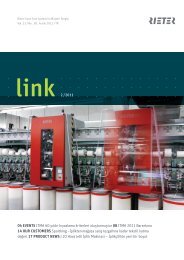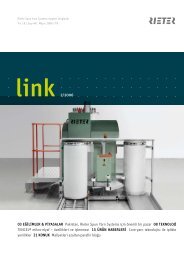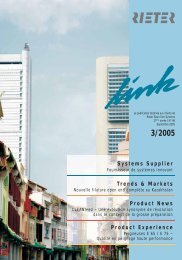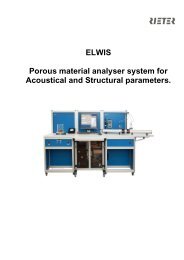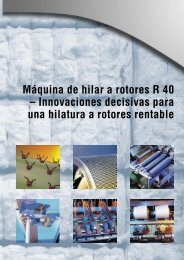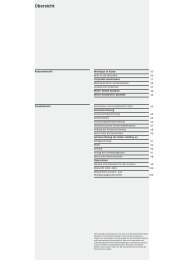You also want an ePaper? Increase the reach of your titles
YUMPU automatically turns print PDFs into web optimized ePapers that Google loves.
Tab. 3 Cost comparison between conventional and compacted ring yarn spun with objective<br />
on optimised resources (deviations to ring spinning in bold type).<br />
Resources / Cost<br />
Conventional<br />
Ring spinning<br />
Compact<br />
Ring spinning<br />
Cost INR € INR €<br />
Cotton Shankar 6 [price/kg] 70. 0 1.04 70. 0 1.04<br />
Raw mat. cost/kg cotton 5) 74.0 1.09 74.0 1.09<br />
Yarn realisation 74% 77%<br />
Clean cotton cost/kg yarn 6) 100.00 1.48 96.1 1.42<br />
Power cost/kg 2.15 0.0 2 1.69 0.025<br />
Conversion cost/kg 40.00 0.59 8.8 0.57<br />
Total production cost/kg 140.00 2.07 1 4.90 2.00<br />
5) incl. handling, storage etc. 6) total raw material cost incl. waste etc.<br />
The production and yarn data used in this article have been<br />
placed at our disposal by courtesy of Sri Balambika Textile Mills<br />
Pvt. Ltd. in Turipur, India.<br />
M. Vijayakumar, General Manager of Sri Balambika Textile Mills<br />
Pvt. Ltd., Turipur, is fully convinced of the advantages of <strong>Rieter</strong><br />
compact spinning machines.<br />
<strong>LINK</strong> 55 . 2 /2010<br />
TECHNOLOGY<br />
Raw material and costs<br />
Raw material and energy costs are the two predominant<br />
parameters in a spinning mill’s cost calculations.<br />
Savings on raw material – a % reduction in comber<br />
noil in this case – directly affect raw material costs<br />
for the yarn in question. Lower yarn twist and the resulting<br />
increase in output at the same spindle speeds<br />
reduce energy costs for the compact yarn by 21%.<br />
Since energy accounts for 14% of the manufacturing<br />
costs, a total cost reduction of % was achieved<br />
(Table ).<br />
Cumulation of the savings calculated above results<br />
in a .6% reduction in total production costs. On the<br />
basis of today’s yarn prices, these savings in resources<br />
increase the spinning mill’s net return on sales by<br />
almost 50%.<br />
Conclusion<br />
The study shows how the qualitative benefits of compact<br />
yarn can be exploited profitably by both spinning<br />
and weaving mills. Even with savings in the<br />
manufacturing process (reduced twist factor) and<br />
raw material (lower noil extraction) compact yarn<br />
still has sufficient reserves in terms of yarn quality.<br />
It still displays significantly better yarn and processing<br />
properties than a conventional ring-spun yarn.<br />
Spinning mills benefit from reduced costs and downstream<br />
processors from better processing properties.<br />
Spinning compact yarns offers lower manufacturing<br />
costs with higher quality. 10-107 •<br />
Bert Rusch<br />
Head Product Management<br />
Combing and Ring Spinning<br />
Winterthur<br />
albert.rusch@rieter.com<br />
21



